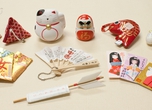Setsubun in Tokyo 2015
Where to go for the traditional bean-throwing festival on February 3

Posted: Fri Jan 23 2015
While the chilly temperatures may suggest otherwise, February 3 traditionally marks the start of spring in Japan. Known as Setsubun (literally, seasonal division), the day is marked with a distinctly spiritual kind of spring cleaning. Its most famous ritual is mamemaki, in which people drive evil spirits from their homes by throwing soybeans out of the door (or at a family member dressed as a demon) and shouting 'Oni wa soto! Fuku wa uchi!' (Demons out! Good luck in!). The ritual is repeated on a larger scale at many temples and shrines around town (see below), usually with a sizable celebrity contingent on hand to scatter that soy. It's then customary to eat a roll of makizushi while facing in the year's lucky direction – hence the dish's name, eho-maki (literally, lucky direction roll). These rolls are sold at pretty much every supermarket and convenience store out there, and in 2015 you'll need to orient yourself in a west-southwestern direction while eating.
Sensoji, Asakusa
If you want to trace the origins of all this bean-throwing stuff, this is where to start: Sensoji was the first place in Japan to hold a large-scale setsubun ceremony, bringing mass-market appeal to a ritual that had been practised since the Heian era. Around 10,000 people turn up each year to watch celebrities lob handfuls of soybeans at 4pm, although you might need to be as superannuated as the average Sensoji worshipper in order to recognise who most of them are. Event starts from 2pm.
Sensoji map and details
Tokyo Tower, Shiba Koen
One of the most bizarre spectacles you'll see on setsubun takes place on the 150m observatory deck of Tokyo's cherished Eiffel Tower rip-off, where a priest from neighbouring Zojoji is joined by the tower's cone-headed Noppon mascots in a quick spot of bean-throwing. When they're done, you can buy some eho-maki from a stall on the same floor. From 10.45am.
Tokyo Tower map and details
Zojoji, Shiba Koen
Kindergarteners in homemade period garb hold a Q&A session with the demons at Zojoji's setsubun celebration, which also features mochi-pounding and bean-throwing by sumo wrestlers and other celebs. From 12noon.
Zojoji map and details
Kanda Shrine, Kanda
Priests in traditional dress emerge from the shrine's ceremonial hall at around 2pm, followed by a bunch of bean-throwers all born in previous Years of the Sheep (the Chinese zodiac animal for 2015). Finally, the red-and blue-faced demons charge onto the scene. From 2pm.
Kanda Shrine map and details
Suitengu Shrine, Ningyocho
While many of Tokyo's shrines and temples let members of the public take part in the bean-throwing, Suitengu is one of the few that doesn't bilk you for the privilege (it's ¥5,000 for adults, ¥2,000 for children). The ceremonies are interspersed by performances of traditional kagura dancing and kamishibai storytelling. Public bean-throwing from 4.30pm.
Suitengu Shrine map and details
Ikegami Honmonji, Ikegami
Seeing around 10,000 visitors for setsubun every year, Honmonji is famed for welcoming athletes (from pro wrestlers to golfers) to take care of the bean-throwing. Things get underway at 1pm, but the actual bean-throwing ceremony doesn't start until 3pm.
Ikegami Honmonji map and details
Hie Shrine, Nagatacho
Always a popular one with tourists, Hie Shrine's ceremony is a real spectacle, from the kagura performances to the entrance parade of the bean-throwers (another chance to spot various celebrities) and the open lottery featuring all kinds of fun prizes. From 11.30am.
Hie Shrine map and details
Yoyogi Hachimangu, Yoyogi
Although the actual bean-throwing at Yoyogi's main shrine is nothing out of the ordinary, the mochi-bashing, put on by the Yoyogi Mochitsuki Preservation Society, makes this one worth a look. Adults are up first from 3.30pm, while small children get their turn after that.
Yoyogi Hachimangu map and details
Hosenji, Nakano
Another setsubun event where the beans are of secondary importance, Hosenji's ceremony is best known for the 'fighting monk' parade, in which 100 men dress up as feudal-era sohei and march along the Ome-kaido from nearby Meitoku Inari Shrine to Hosenji. The parade gets moving from 3.30pm, while beans are thrown from 4.30pm.
Hosenji map and details
Tags:
Tweets
- About Us |
- Work for Time Out |
- Send us info |
- Advertising |
- Mobile edition |
- Terms & Conditions |
- Privacy policy |
- Contact Us
Copyright © 2014 Time Out Tokyo














Add your comment